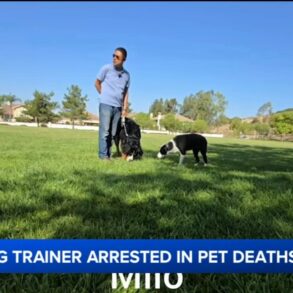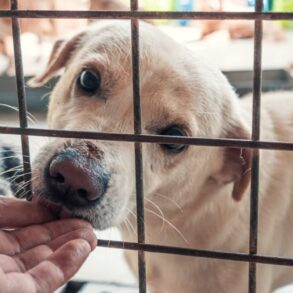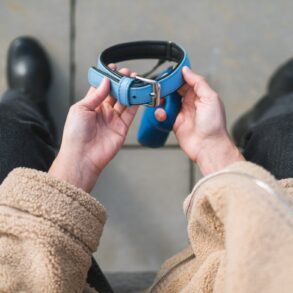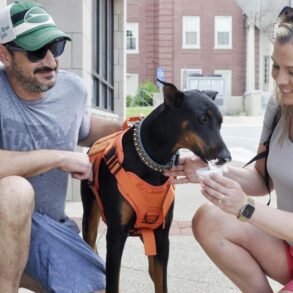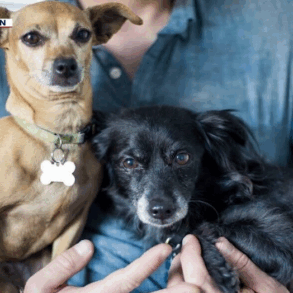Editor’s note: In Police1’s recent “What Cops Want in 2024” survey, 2,833 officers opened up about the programs and services they need to support their physical and mental wellbeing. Fourteen percent of respondents reported their agency had a therapy animal program, highlighting a growing trend in officer wellness options. This article explores how departments can set up a therapy dog program.
Chief Brandon Gurley vividly remembers his reaction when one of his sergeants approached him with the idea of getting a therapy dog for the department. “I didn’t want a house pet running around the building and being a distraction to our team members,” says the 25-year law enforcement veteran at the helm of the Brookhaven Police Department.
Eight months later, “Collin has established credibility,” says Gurley with a smile. He looks at the three-year-old Pitbull retriever mix lying at his feet as the morning sun pours through large windows into the city’s glass and granite public safety building.
Poor state of police officers’ mental wellness
Brookhaven, a 95-officer agency in Metro Atlanta, is in line with a trend where law enforcement agencies around the country are adding therapy dogs to their force, separate from the standard police K-9s, to boost officers’ mental wellness and resiliency.
The concept was inspired by the military. For almost two decades, specially trained dogs have helped combat veterans cope with depression, anxiety and PTSD. Therapy dogs are also used in victim assistance programs, courts and medical settings — especially children’s hospitals.
“Mental illness is not just something that impacts the community our officers serve,” says Gurley. “It impacts our officers, too, as they work under a great deal of stress.”
Research shows that police officers are more likely to die from heart conditions at a much younger age than the general public. Rates of depression, anxiety, burnout and post-traumatic stress are also significantly higher in law enforcement. Some studies suggest that 30% of cops have a substance abuse problem. Alcohol dependence is at the top of the list. Over the last few years, more police officers have died by suicide than were killed in the line of duty, according to First H.E.L.P., a first responder advocacy group.
Among the vanguard of law enforcement agencies pushing officer wellness programs and adding therapy dogs to their teams is the Georgia Department of Public Safety, which launched its Office of Public Safety Support in 2019.
The office dispatches its four dogs and their handlers, who are also peer support specialists, to public safety agencies all over Georgia to help with critical incident debriefings and mental wellness education and interventions. The office has helped agencies in neighboring states, as well, and sent teams to Washington D.C., after the January 6, 2021, riots, to support police officers.
Therapy dogs “are a phenomenal asset,” says the Office’s deputy director, Lieutenant Stacey Collins. The Georgia state trooper is the handler of K9 Kylo, a Newfoundland Poodle. “Just to see how these canines can help people who are hurting is very gratifying,” he says about his work with officers from various agencies.

The Georgia Department of Public Safety sent Lieutenant Stacey Collins and K9 Kylo, a Newfoundland Poodle, to Washington D.C., after the January 6, 2021, riots, to support police officers.
Photo/Georgia Department of Public Safety
Research confirms benefit of therapy dogs
In Brookhaven, Sergeant Matthew Murray, Collin’s handler and the officer who pushed the idea to get a therapy dog, is all too familiar with the healing power of canines. Before becoming a police officer, Murray worked as a firefighter and EMT, served as a submariner in the Navy and later spent two years as a combat medic in Iraq. Time and time again, he’s seen “big, tough soldiers come out of a firefight and pet a dog. I could watch the stress melt off of them.”
Collin, with light brown fur and amber eyes, is trained and credentialed as a “Public Safety Assistance Canine” (PSAC) — a type of therapy dog — through the Georgia-based non-profit Tails of Hope. The organization specializes in training dogs to support disabled and traumatized children, military veterans and first responders.
Murray makes sure to use the official term because “if you start mentioning words like ‘therapy’ around cops, they have the tendency to shut down.” But with a fancy acronym, chances are higher to get buy-in from the officers, he adds with a smile.
The terminology can be confusing, but it’s key to understand the differences, says Kerri Rodriguez, assistant professor of Psychology at the University of Arizona’s College of Veterinary Medicine. She studies the impact of human-animal interaction on military veterans and first responders.
Dive into the insights of 2,833 officers on their wellness needs and find out how police leaders can lead the way in implementing support strategies
Service dogs are trained on the highest level and are primarily assigned to a single individual. They assist people with disabilities like vision and hearing impairments. They are also trained to detect the early onset of seizures and to help alleviate anxiety, depression, or phobias.
Therapy dogs, on the other hand, “provide support to many different individuals,” explains Rodriguez. Facility dogs are a subcategory. “These are full-time therapy dogs that work at a facility, like a courthouse, to help people with stressful testimonies,” the researcher says. Facility dogs in police and fire departments, like Collin, are often referred to as station dogs.
Many of these dogs are trained and placed by non-profit organizations such as Tails of Hope, K9s for Warriors or Puppies Behind Bars, where inmates train dogs. These organizations are certified through Assistance Dogs International. The dogs and their handlers often become registered therapy animal teams through credentialing organizations like the American Kennel Club and Pet Partners.
There is a lot of anecdotal but also increasing scientific evidence that dogs have a positive impact on relieving the effects of burnout, stress and trauma. Research found that interaction with dogs can lower a person’s heart rate and blood pressure, decrease the level of cortisol, known as the stress hormone, and boost oxytocin, a hormone linked to increased social interaction and well-being.
Rodriguez is currently involved in two studies about the benefits of therapy dogs for law enforcement. Working with police officers for her research, she’s seen that — in addition to the physiological indicators or relaxation — “just sitting down and petting a dog can promote a mindfulness effect, where the officer is focusing on the dog’s fur and their own breathing” — and for a moment, not thinking about a stressful case or traumatic experience.
She says the mental break and the non-judgmental nature of the dog may help soften the hardened veneer of police officers and open the door for other types of mental wellness interventions if needed, whether it’s peer support or professional counseling.
Stress detection through smell and touch
Dr. Mark Kirschner has seen this effect at work many times. “There is a great value to interactions with a dog,” says the police psychologist who practices near New Haven, Connecticut. He often asks for a therapy dog when he’s called into a department to conduct a critical incident debriefing, especially in the case of an officer-involved shooting or an officer’s death.
During these debriefings, the officers may not want to talk to him, he says, or a peer support team member. They may not want to talk about the incident at all. “But it’s hard to ignore the dog,” says Kirschner.




Collin has his own Instagram account and challenge coin and has become an unintended yet powerful PR tool for the police department.
Photo/Brookhaven PD
The animal helps ground people, he adds, “bring them down from their adrenaline pumped, emotional state” – and hopefully, reduce the resistance to talk.
Brookhaven Police Department’s Collin has already made a difference, even though he’s been with the agency for less than six months. “I’ve seen people who I didn’t know could smile do smile when Collin comes around,” says Chief Gurley.
Murray, who also serves as the department’s emergency management coordinator, remembers a recent command staff meeting that he and Collin attended. As a team member talked about a friend from a neighboring agency who died unexpectedly, Collin walked over and put his head on the man’s lap.
“He could sense the officer was upset,” says Murray. Service dogs and therapy dogs are trained to detect a heightened level of stress in a person — mainly by smell and touch — and to interrupt the stress cycle by engaging the individual.
It’s one reason why Collin mostly stays around the station and its staff. As he gets to know the people in the department, “he learns what their baseline is, so he can pick up on any behavioral change,” the handler explains.
Occasionally, Murray takes the dog to community events like Coffee with a Cop, a city council meeting, or an arts festival. Collin, who wears a black-and-red vest and has his own Instagram account and challenge coin, has become an unintended yet powerful PR tool for the police department.
On most days, Murray has a staggered schedule so he and Collin can attend roll calls for different shifts and, if necessary, critical incident debriefings. They make rounds through patrol, CID, evidence and property, administration and courts.
Financial, logistical and staffing challenges
Despite plenty of heartwarming anecdotes and a growing body of research, having a therapy dog embedded in a police department comes with challenges. The International Association of Chiefs of Police (IACP) has published a tip sheet about facility and therapy dogs.
Police psychologist Kirschner says departments thinking about getting a station dog need to have realistic expectations and be aware that “it’s a big commitment.”
For one, it’s a financial commitment. There are training costs for the dog and handler, plus food, veterinarian bills and additional liability insurance. In some cases, dog placement organizations provide the dog for free. Sometimes, grants are available, or the local police foundation picks up part of the cost, as in the case of Brookhaven.
Getting a station dog also poses logistical, regulatory and legal challenges. For example, mitigating employees who are afraid of dogs or have pet allergies, says Kirschner.
It can be a staffing issue, too. The handler dedicates at least half of their time to training and working the dog, which can be difficult when many departments are struggling to fill their ranks, especially smaller agencies.
The long-term success of a station dog program relies on having the right handler for the dog, says state trooper Collins. His advice to agencies is to find an officer who fully understands the responsibilities. A therapy dog is with the handler 24/7, he says. “They live with you. They work with you. They travel and train with you.”
It’s also critical to define the dog’s role and its value and purpose to the department and the community, adds Brookhaven police chief Gurley, “to make sure it aligns with our culture.”
Brookhaven police have been early adopters of mental wellness initiatives for officers and the community. A few years ago, the agency launched a co-responder program, where police officers and clinicians jointly respond to certain calls involving people in mental crisis. It also has a peer support team and a licensed professional counselor on staff.
Kirschner says that a therapy dog is a great tool for a police department to have and a valuable component of an officer wellness program. The dog can serve as an icebreaker and a conduit, reducing the stigma of seeking professional help. “But it doesn’t replace therapy for those who need it, and it’s not the wellness program’s sum total,” he warns.
And most importantly, it’s not a house pet.
NEXT: Is your department considering adding a wellness dog to its ranks? Check out how Murphy, Chula Vista (Calif.) PD’s first official wellness dog, is making his mark at the department by boosting officers’ morale and mental health.
This post was originally published on this site be sure to check out more of their content.








